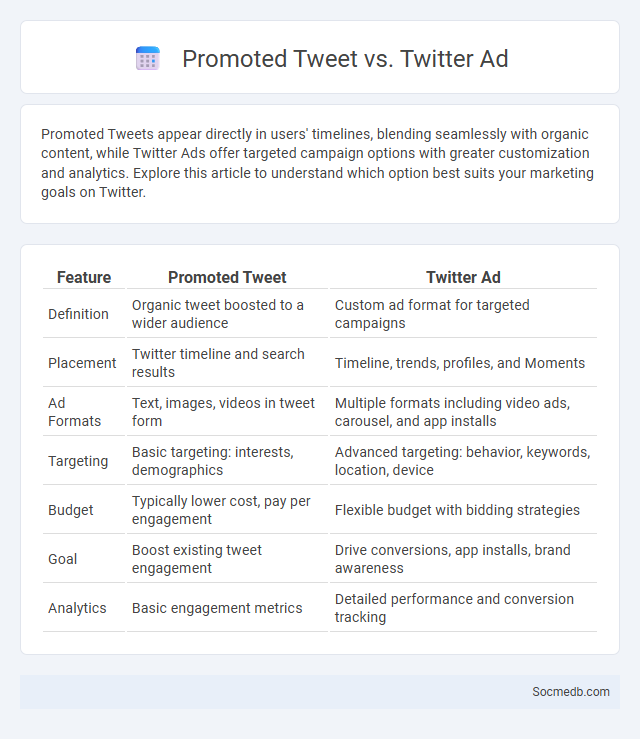
Photo illustration: Promoted tweet vs Twitter ad
Promoted Tweets appear directly in users' timelines, blending seamlessly with organic content, while Twitter Ads offer targeted campaign options with greater customization and analytics. Explore this article to understand which option best suits your marketing goals on Twitter.
Table of Comparison
| Feature | Promoted Tweet | Twitter Ad |
|---|---|---|
| Definition | Organic tweet boosted to a wider audience | Custom ad format for targeted campaigns |
| Placement | Twitter timeline and search results | Timeline, trends, profiles, and Moments |
| Ad Formats | Text, images, videos in tweet form | Multiple formats including video ads, carousel, and app installs |
| Targeting | Basic targeting: interests, demographics | Advanced targeting: behavior, keywords, location, device |
| Budget | Typically lower cost, pay per engagement | Flexible budget with bidding strategies |
| Goal | Boost existing tweet engagement | Drive conversions, app installs, brand awareness |
| Analytics | Basic engagement metrics | Detailed performance and conversion tracking |
Understanding Promoted Tweets
Promoted Tweets are paid advertisements that appear seamlessly within Twitter feeds, targeting specific audiences based on demographics, interests, and behaviors to maximize engagement. Your campaign's success relies on crafting compelling content and strategically using Twitter's targeting options to reach potential customers effectively. Monitoring performance metrics like impressions, clicks, and conversions helps optimize your promoted tweets for higher ROI.
What Are Twitter Ads?
Twitter Ads are paid promotional messages on Twitter designed to increase your brand visibility, engagement, and website traffic. They include various formats such as Promoted Tweets, Promoted Accounts, and Promoted Trends, targeting specific audiences based on demographics, interests, and behavior. Using Twitter Ads, you can reach millions of active users, making it an efficient tool for your digital marketing strategy.
Key Differences Between Promoted Tweets and Twitter Ads
Promoted Tweets appear directly within users' timelines and blend seamlessly with organic content, offering enhanced visibility for specific messages without disrupting the user experience. Twitter Ads encompass various formats such as Promoted Accounts and Promoted Trends, allowing brands to target users more broadly based on interests, demographics, and behaviors. While Promoted Tweets emphasize individual tweet engagement, Twitter Ads provide comprehensive campaign options for brand awareness, follower growth, and event promotion.
Types of Twitter Advertising Options
Twitter advertising offers various types tailored to different marketing goals, including Promoted Tweets, which amplify your posts to a targeted audience for increased engagement. Promoted Accounts help grow your follower base by showcasing your profile to users interested in similar content. Video Ads enable you to capture attention with dynamic content, while Twitter Amplify pairs your ads with premium video content for greater reach and brand association.
How Promoted Tweets Work
Promoted Tweets are paid advertisements on Twitter designed to reach a broader audience beyond your followers by appearing in users' timelines, search results, or profiles. You can target specific demographics, interests, keywords, or locations to ensure your message reaches the most relevant audience, optimizing engagement and conversion rates. Twitter's algorithm helps deliver Promoted Tweets to potential customers based on their behavior and interactions, maximizing the impact of your social media marketing efforts.
Benefits of Using Promoted Tweets
Promoted Tweets on Twitter increase brand visibility by targeting specific demographics, ensuring content reaches an engaged audience. This advertising method boosts engagement rates, including likes, retweets, and click-throughs, driving higher website traffic and conversions. Real-time analytics offer valuable insights to optimize campaigns for maximum return on investment and audience reach.
Advantages of Twitter Ad Campaigns
Twitter Ad Campaigns deliver targeted audience reach by leveraging advanced demographics and interests data, ensuring your message connects with potential customers effectively. The platform offers real-time engagement metrics, allowing you to optimize your campaigns for maximum ROI and brand visibility. By utilizing Twitter's vast user base, your business can drive increased website traffic, generate leads, and boost conversions efficiently.
Cost Comparison: Promoted Tweet vs Twitter Ad
Promoted Tweets typically offer a more budget-friendly option, costing between $0.50 to $2.00 per engagement, making them ideal for targeted reach and brand awareness. Twitter Ads, with costs varying widely from $0.50 to $6.00 per click depending on campaign objectives and competition, provide advanced targeting and analytics for comprehensive marketing strategies. You can optimize your social media budget effectively by evaluating specific goals and engagement metrics between these two advertising formats.
Choosing the Right Option for Your Business
Selecting the ideal social media platform hinges on understanding your target audience's behavior and preferences to maximize engagement and brand visibility. Analyzing metrics such as user demographics, content type, and platform features enables you to tailor your marketing strategy effectively. Your business growth depends on leveraging these insights to choose channels that align with your goals and foster authentic connections.
Best Practices for Twitter Advertising Success
Maximizing Twitter advertising success requires precise audience targeting using Twitter's advanced tools such as Tailored Audiences and Twitter Analytics to refine campaigns. Crafting engaging, concise content with strong calls-to-action, combined with A/B testing various ad formats like promoted tweets and video ads, significantly improves engagement rates. Consistent monitoring of key performance indicators including click-through rates (CTR), conversion rates, and engagement metrics enables ongoing optimization for enhanced return on investment (ROI).
 socmedb.com
socmedb.com